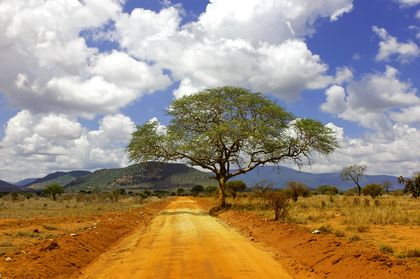CHAD

Republic of Chad
République du Tchad
COUNTRY OVERVIEW
LOCATION AND SIZE.
The former French colony of Chad, a landlocked country located in northern Central Africa, is more than 3 times the size of California. The country has an area of 1,284,000 square kilometers (495,755 square miles), with a land boundary length of 5,968 kilometers (3,708 miles). Neighboring countries are Niger, Nigeria, and Cameroon to the west; Libya to the north; Sudan to the east; and the Central African Republic (C.A.R.) to the south. Lake Chad in the southwestern part of the country is the largest body of water in the Sahel region. Chad also has the Tibesti mountain range in the far north, some smaller mountains in central Chad, and a few hills near the southern and western borders. Most of the country is desert or savanna with limited rainfall, although there are moderately temperate areas in the south. Chad's capital, N'Djamena, is in the southwestern part of the country.
POPULATION.
In July 2001, the population of Chad was estimated at 8,707,078, an annual growth rate estimated of 3.29 percent. The birth rate is estimated at 48.28 per 1,000 people and the death rate at 15.4 per 1,000 people. Most of the population, half of which is under the age of 15, lives in several southern provinces where high rainfall makes farming and animal husbandry easier. About 1 percent lives in the arid upper half of the country extending into the Sahara desert. Population density varies between 0.15 persons per square kilometer (0.39 per square mile) in the northern province and 61.7 persons per square kilometer (154 per square mile) in the Logone Occidental province.
MANUFACTURING.
Based in Moundou, Chad's most important industrial company, Cotontchad, gins cotton and manufactures soap and oil from cottonseed. Cotontchad also has ginning operations in several large southern towns. In addition to Cotontchad, Moundou has a cigarette company and a firm that assembles agricultural equipment. In N'Djamena, several companies produce paint, metal roofing, fruit drinks, mineral water and cookies. Chad's third largest city, Sahr, hosts a sugar production factory and an idle textile mill.
PETROLEUM.
Chad's petroleum industry will be extremely important in the short-term future. There are plans to exploit 2 known petroleum deposits: a small reserve of high-grade oil north of Lake Chad and a much larger deposit of heavy crude oil in the Doba Basin of southern Chad. A consortium led by Exxon will employ up to 4000 workers and invest US$3.7 billion to exploit over 1 billion barrels in the Doba basin. Further exploration is planned to determine whether more reserves can be exploited.
MINING.
A South Korean company, AFKO, recently began building a factory to extract gold reserves near the southern town of Pala. Chad is known to hold deposits of bauxite, iron ore, uranium, tin, and tungsten, but further research is necessary to determine whether these resources can be extracted.
FINANCIAL SERVICES.
Chad's banking sector is small by international standards. With US$100 million in deposits and limited capital investment, Chadian banks have little money to lend. Much of their capital finances the cotton-buying season for Cotontchad. For other businesses, credit is expensive and difficult to obtain. Short-term credit can cost 18 to 26 percent and long-term credit is rarely available.
RETAIL.
The retail business is conducted primarily in the informal sector. Thousands of vendors wander in Chad's urban streets searching for buyers for their wares. In addition, thousands of small stores and roadside stands sell limited varieties of household goods. In rural and urban areas, many vendors gather in a network of small markets where perishable goods are sold.
TRANSPORTATION.
Transport of goods is managed by many informal sector operators. Small vehicles and large semis carry passengers and merchandise between N'Djamena and different regional centers. Most vehicles are old and break down often.
DEPENDENCIES
Chad has no territories or colonies.
BIBLIOGRAPHY
Economist Intelligence Unit. Country Report: Cameroon, Central African Republic and Chad, 2nd Quarter, 1999. London: Economist Intelligence Unit, 1999.
"Chad at a Glance." World Bank Group. <http://www.worldbank.org/data/countrydata/aag/tcd> . Accessed January 2000.
"Chad Country Brief." World Bank Group. <http://www.worldbank.org/data/countrydata/aag/tcd> . Accessed January 2000.
"Chad Data Profile." World Bank Group. <http://www.worldbank.org/data/countrydata/aag/tcd> . Accessed January 2000.
Embassy of Chad in the United States. <http://www.chadembassy.org> . Accessed October 2001.
International Monetary Fund. <http://www.imf.org/external/country/TCD/index> . Accessed January 2000. "Tchad." Marché Tropicaux Special Edition. May 28, 1999.
U.S. Central Intelligence Agency. World Factbook 2001. <http://www.odci.gov/cia/publications/factbook/index.html> . Accessed October 2001.
U.S. Department of State. FY 2001 Country Commercial Guide: Chad . <http://www.state.gov/www/about_state/business/com_guides/chad> . Accessed December 2000.
—Alexander Gazis
CAPITAL:
N'Djamena.
MONETARY UNIT:
Central African franc (CFA Fr). 100 CFA Fr equals 1 French franc. There are coins of 5, 10, 25, 50, 100, and 500 CFA Fr. In the local marketplace, money is expressed in terms of "riyal," a unit equal to 5 CFA Fr. Thus 500 CFA Fr equals 100 riyal.
CHIEF EXPORTS:
Cotton, cattle, textiles, gum arabic.
CHIEF IMPORTS:
Machinery and transportation equipment, industrial goods, petroleum products, foodstuffs, textiles.
GROSS DOMESTIC PRODUCT:
US$8.1 billion (purchasing power parity, 2000 est.).
BALANCE OF TRADE:
Exports: US$172 million (f.o.b., 2000 est.). Imports: US$223 million (f.o.b., 2000 est.).